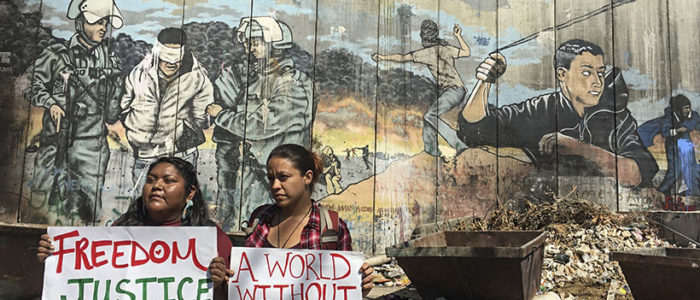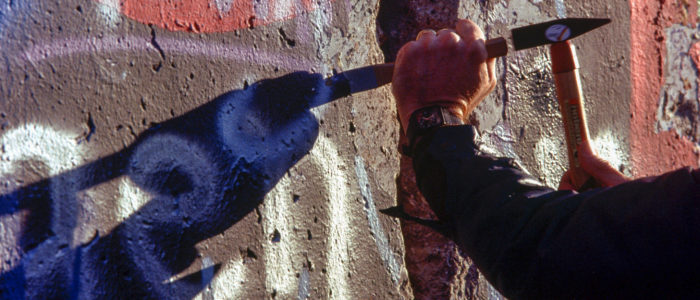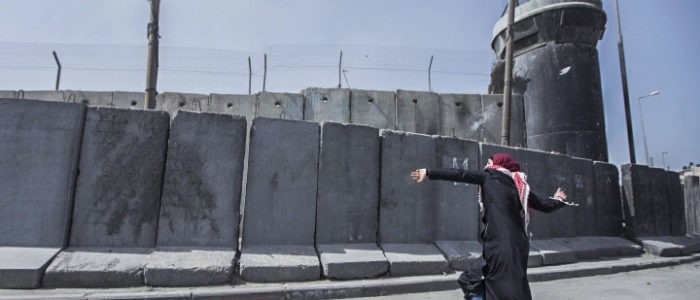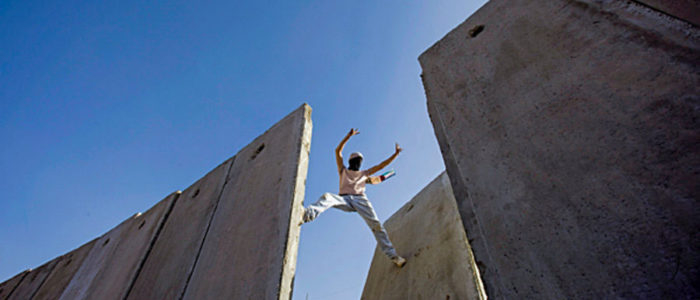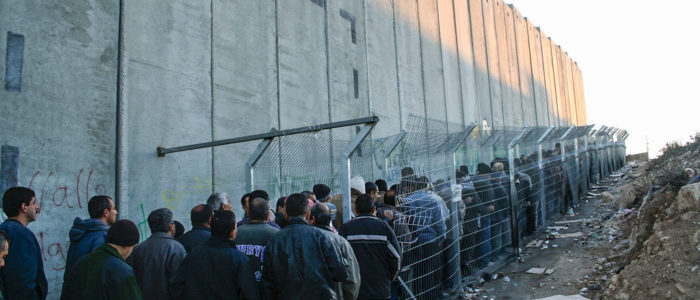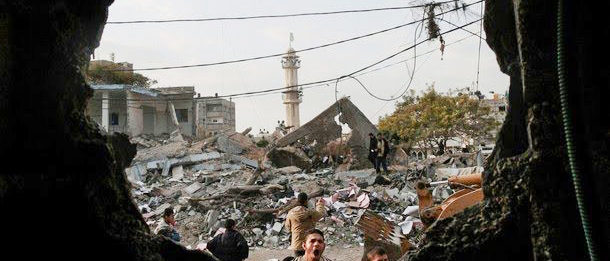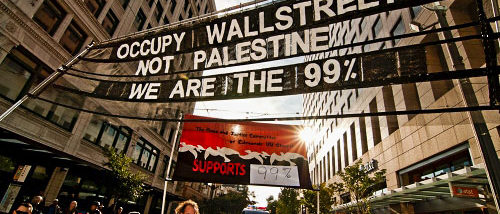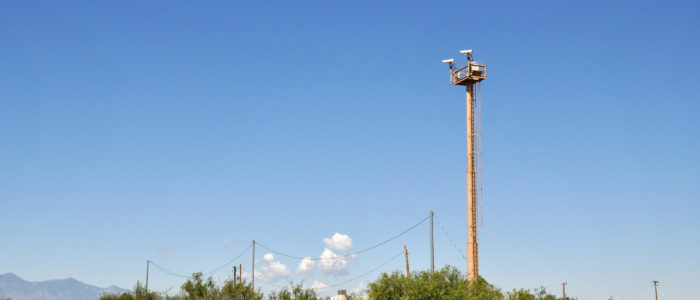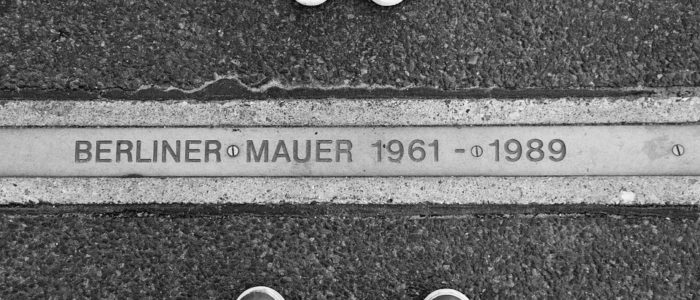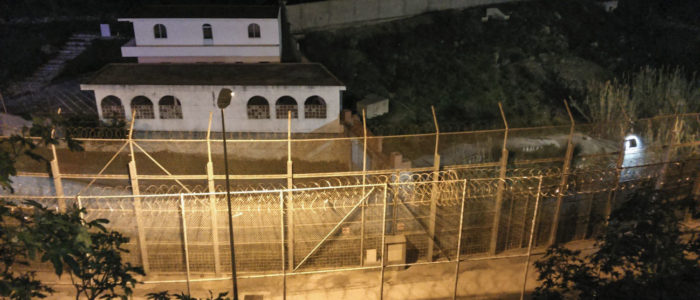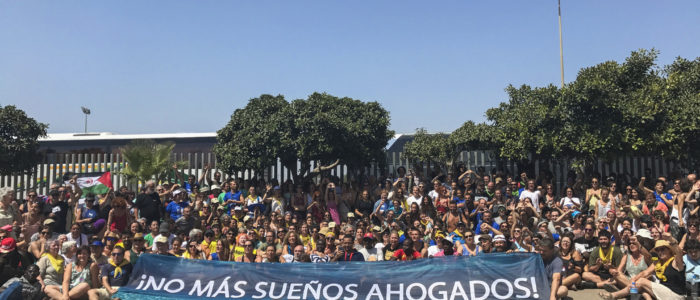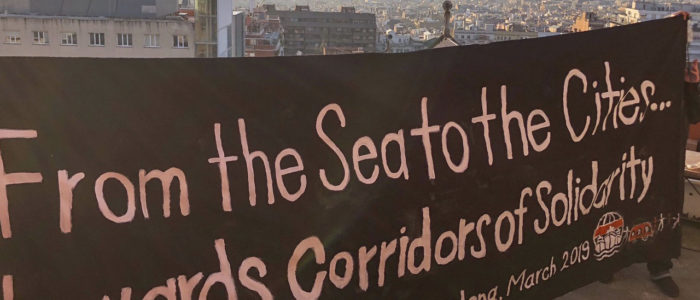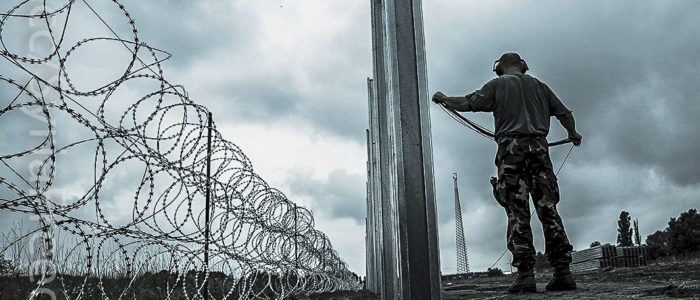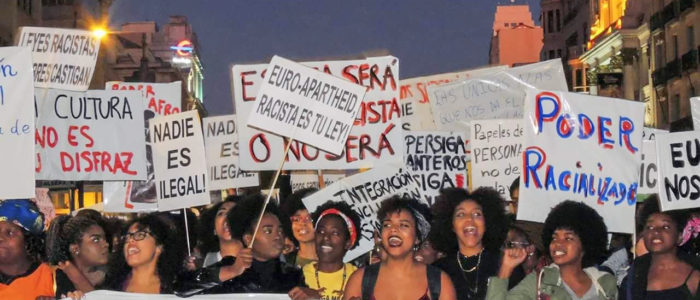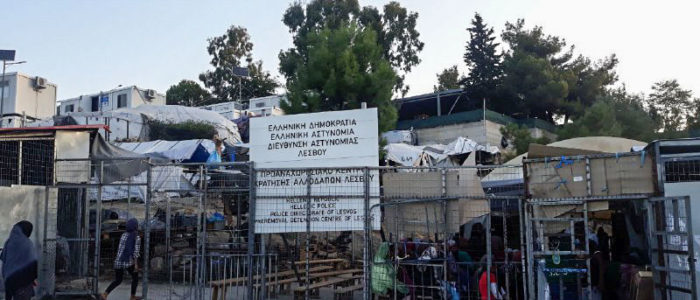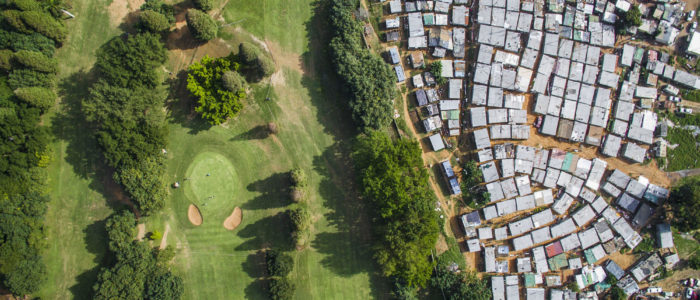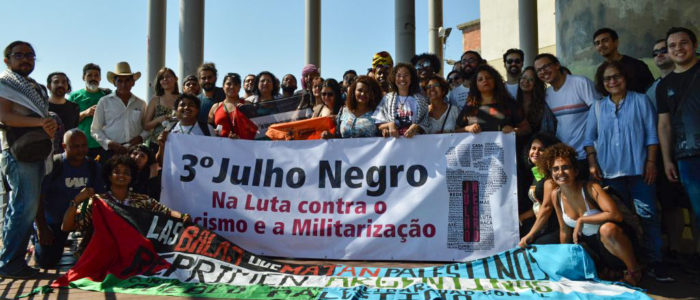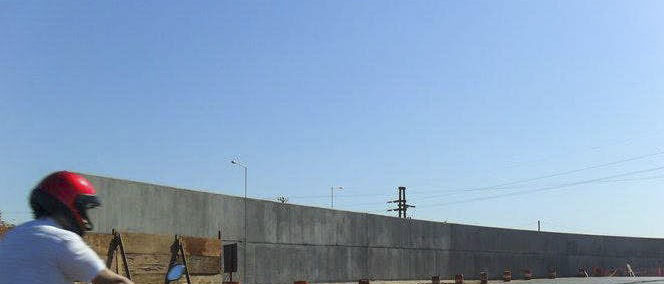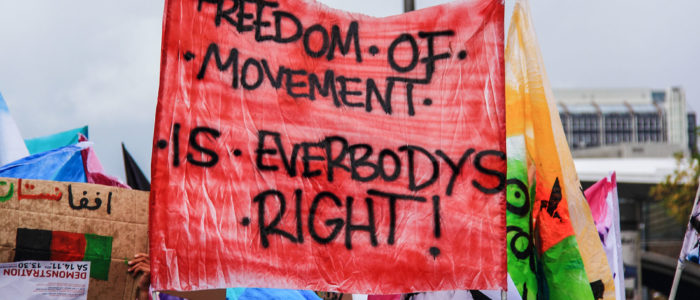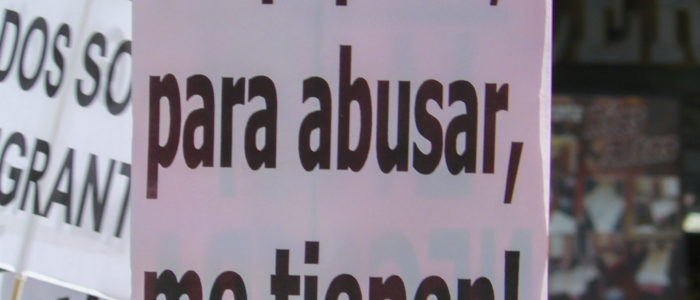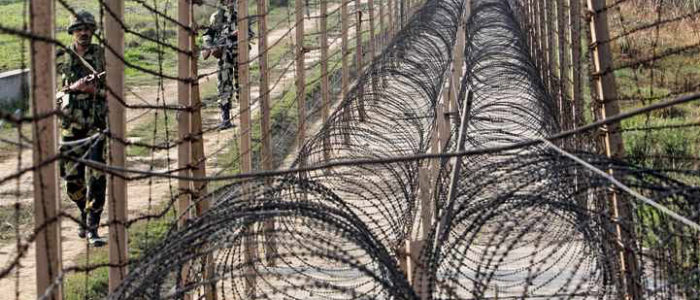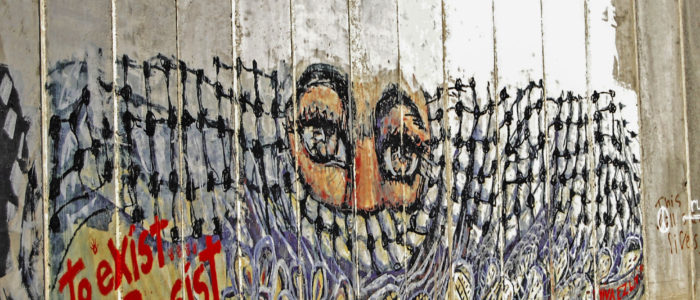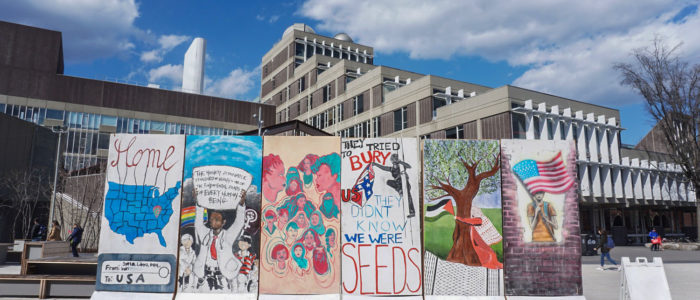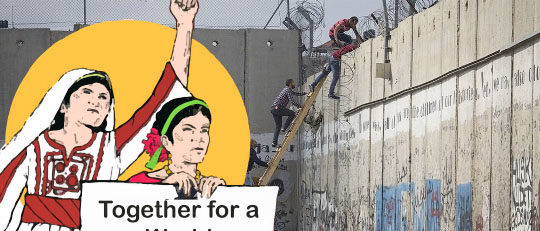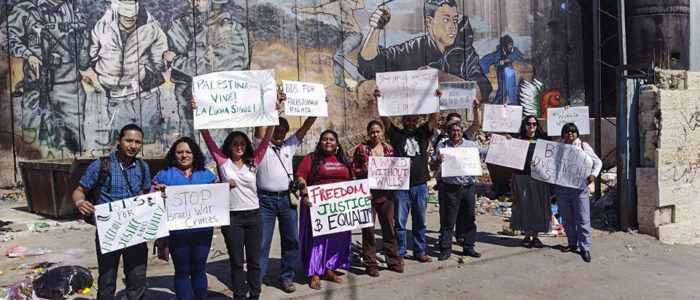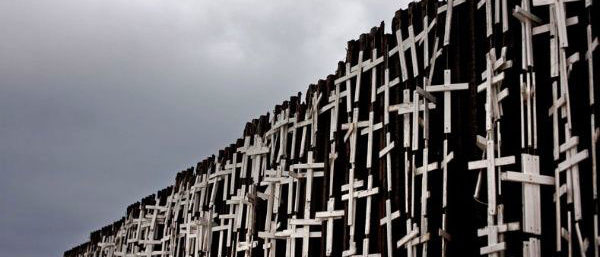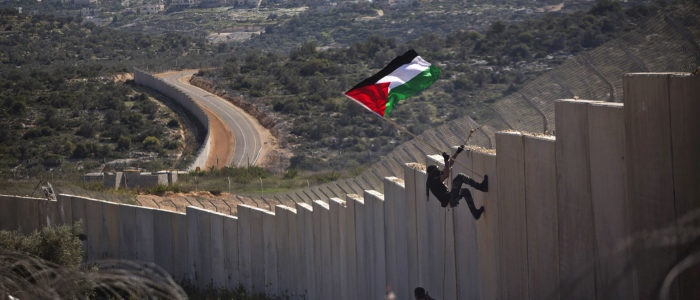Nation of Walls: colonialism, racism, and walls in the United States
A protest of the Occupy Seattle marches from the city center to the seat of Bank of America. (Credits: Tyler Stringfellow/IPS.)
Resistance to borders and separation barriers is one of the urgent, global, and galvanizing struggles of our time. While in recent history, border walls were stigmatized on the world stage — particularly because the Berlin Wall symbolized division and oppression — currently separation barriers are being pursued by various states and embraced as legitimate by right-wing politicians around the world. From the Middle East to North America, Europe to Africa, governments are erecting walls as means of controlling the mobility of oppressed groups of people and dividing populations along national lines.
The United States and Israel are leading the way — disastrously — in legitimizing and constructing such walls. The Israeli construction of its wall across the West Bank, beginning in 2001, was a highly public attack on the Palestinian freedom of movement and an effort to further entrench Israeli control over Palestinian territory. That project also served as a provocation against international sensibilities regarding walls. Despite condemnation by the UN General Assembly, the International Court of Justice, the Red Cross and various human rights organizations, Israel pursued the construction of the wall. The state then embarked on other separation barriers—on its southern border with Egypt, along the edges of the Gaza Strip, around the Syrian Golan Heights—which Israel occupies, on part of its eastern border with Jordan, and along its northern border with Lebanon.
The United States has encouraged Israeli wall building. It vetoed efforts to condemn the West Bank wall in the UN Security Council. It has continued with unabated aid to Israel throughout the wall construction. And numerous US politicians, such as senators Hillary Clinton and Chuck Schumer have argued that the wall is justified as a means to stop terrorism. President Trump has celebrated Israeli walls most enthusiastically, referring to them during and after his 2016 election campaign, both affirming the Israeli wall-building projects, and drawing upon their perceived legitimacy to justify the US’ own wall-building along its border with Mexico.
The United States, in addition to fortifying the borders bounding its own territory, is aggressively encouraging the militarization of other states’ borders. A program carried out by the Department of Defense that directs aid to Lebanon, Pakistan, Oman, Egypt, Jordan, and Tunisia for border security1 is one of several that the US has to fund the reinforcement of borders around the world. The Omani government is using these funds to build a separation barrier on its border with Yemen.2 On Jordan’s borders with Iraq and Syria, the US weapons manufacturer Raytheon is partnering with the Jordanian government to build a patchwork of physical barriers, automated sensors, watchtowers and other surveillance technology.3 This set of tools for controlling movement is called the “smart wall” in US domestic politics. Still controversial and being debated in the United States regarding its border with Mexico, the US is already helping to construct a “smart wall” in Jordan. US corporations like Raytheon and Israeli ones like Elbit Systems are involved in border militarization projects the world over. The US and Israel therefore, through ideologically legitimizing border walls and fences, materially funding their construction, and developing the technologies that constitute their infrastructure, are at the vanguard of efforts to divide the world with walls.
While the contemporary moment is a critical chapter in wall-building around the world though, it is important to recognize the histories of constructing fences and walls to separate groups of people, which serve as foundations for the pursuit of separation barriers today. The United States in particular has a history in which separation barriers have been built to colonize the land and create and enforce geographies of racist segregation. Specifically, the development of the United States as a national project involved European settlers erecting barriers to keep Indigenous peoples outside of settled territories, and white Americans built walls in US cities to confine Black residents to some parts of cities and prevent them from accessing others.
In fact, building walls was a central activity of the original English settlers in their establishment of the colonies from which the United States emerged. In both Jamestown, Virginia4, and Plymouth, Massachusetts — the English settlements from which the US draws its origin story — settlers constructed palisades, or fortified walls, at the edges of their settlements.
In 1621, months after arrival in Massachusetts, the Pilgrim settlers of Plymouth began construction on their wall. The Pilgrims landed in Plymouth in December 1620, and their settlement came to involve the seizure of land, attacks on groups of Natives, and forming alliances with some Indigenous groups against others. The settlers formed a militia, which was commanded by Myles Standish, an English soldier and veteran of wars in Europe. Standish’s military leadership over the course of his role in the English settlement of Massachusetts was characterized by an aggressive posture and massacres of Natives. By late 1621 the Pilgrims’ actions provoked a defensive response by the Narraganset people. Under Standish’s direction, the colonists reacted by erecting an eight-foot high wall that was more than half a mile in length. This act was not only aimed at repelling the Native population, but also asserting control of territory by the English. As historian Nathaniel Philbrick writes, by building the wall, “the Pilgrims had made it clear that they intended to remain there for a very long time.”5
There is a more famous wall, at least in its legacy, in Manhattan. Wall Street, the center of global finance, is named for a wall that Dutch settlers built as part of their settlement of the island. After initial warm relations between the Dutch and the Lenape people inhabiting the region, in which Native leaders gave the settlers permission to occupy the southern part of Manhattan Island, colonial leader Willem Kieft launched a series of massacres of Lenape.6 This provoked a conflict between the settlers and Natives, called Kieft’s War.7 It was in that context that the Dutch, using both settler labor and that of enslaved Africans,8 built a double palisade as a defense against the hostility that they provoked. The passageway between the two walls became Wall Street.
The histories of these walls built in the early colonies that would become the United States show that the roots extending from the current wall-building projects that the US is pursuing and supporting are deep ones. Among the very first acts taken by the founders of the US project were the construction of separation barriers for the purposes of colonization.
The United States’ urban walls
The histories of racist wall-building in the United States do not only include the actions of the early settlers in their theft and colonization of Native lands. Separation barriers have also been part of the racial segregation of US society to promote white supremacy and racist oppression. Exploring histories of such walls involves an appreciation for racial segregation itself. Indeed, the segregated geographies of the United States’ landscape, particularly in the country’s cities, have constituted a central component of racism in the US. While the resulting urban landscapes have involved marginalized ethnic enclaves impacting various racialized populations — including, for example, Chinese Americans and other Asian migrants confined to “Chinatowns” — the architecture confining and restricting the movement of Black Americans in particular has been foundational and evolving over the course of US history.
Black people’s residence, movement, and other activities have historically been restricted through a combination of the law, actions by government agencies, and white supremacist violence. As scholars like Keeanga-Yamatta Taylor9 and Richard Rothstein10 have argued, segregation in housing involved a collaborative effort between the real estate industry, the Federal Housing Administration, municipal governments and white private citizens. Perhaps the most well-known method of carrying out systematic racist discrimination in housing was known as “redlining”. This involved the federal government working with real estate companies to designate sections of US cities to be inhabited by Black people, and other sections that excluded them. Government actors developed a system of encouraging and discouraging housing loans based on the notion that lending to Black people incurred greater risk, and even proximity to Black homeowners threatened home values. This involved practices of extending and denying housing loans to Black and white families in differential ways that promoted and cemented racially segregated cities. In addition to financial practices that led to segregation, separation barriers were built in some US cities as highly visible and functional enforcers of racist division. The history of such fences and walls predates and extends into 20th century practices like redlining.
At least two separation barriers were built in the Washington, DC area, for example. The LeDroit Park neighborhood in Washington was designed as an all-white enclave in the 1870s. Adjacent to Howard Town, the area surrounding the historically Black Howard University, the developers of the neighborhood built a high fence around LeDroit Park and stationed guards at its gates to control the entry of people. Black people were prevented from accessing the enclave.11
In Arlington, Virginia, just across the Potomac River from Washington and home to many who work in the city, the 1930s saw white residents in areas beside the Black neighborhood of High View Park build sections of wall to prevent their Black neighbors from entering. These sections ultimately became a contiguous separation barrier, called “Hall’s Hill Wall,” after the Black neighborhood it circumscribes.1213
Detroit’s 8 Mile Wall, also known as the “Birwood Wall” and “Detroit’s Wailing Wall,” illustrates starkly the ways that federal policy and private citizens built walls of segregation.14 Named for 8 Mile Road, near where the wall is located, (not for the wall’s length), the barrier was built during property development efforts in the 1930s. This coincided with the creation of the Federal Housing Administration (FHA) in 1934, the US government agency that set standards for home loans and guaranteed mortgages of home owners and developers. Initially, developers were denied support from the FHA for their housing construction projects in the area around 8 Mile Road due to the proximity of Black residents. They responded by building a six-foot high, half-mile long wall to keep Blacks out of the proposed development. The FHA then reversed its decision and approved financial support.15
The American experience regarding social and political division through colonial and racist barriers helps explain the tendency in the US to accept as natural or reasonable separation along national and racial lines today. US society is characterized by wildly divergent, racialized geographies. It is typical for US cities to be divided into “Black neighborhoods,” “white neighborhoods,” and other racialized spaces. Moreover, the legacy of the American “frontier” continues to occupy a presence in US society, both in its history and as a point of reference in contemporary understandings of US politics and racial conflicts. That legacy includes tropes involving white settlers on the edges of colonized space, defending themselves from hostile natives in uncontrolled areas, such as the “Wild West.”
These notions of conflict between racial groups of people over the sharing and control of space are not natural. They are produced by histories in which political actors carried out racialized segregation across the land, with separation barriers playing a role throughout. The acceptance, however, of segregation as a natural phenomenon informs Americans’ current understandings of conflicts in which racist division and nationalism play key roles. The notion, for example, that it is impossible for Palestinians and Jewish Israelis to share the land of Palestine in peace and equality, resonates with many Americans. This is true not only because of the complexities and characteristics specific to the struggles in Palestine, but because of Americans’ own histories with racist division and colonization. Similarly, the notion that Americans today must build a wall on the border with Mexico to prevent intruders from Latin America, or must ban people from predominately Muslim countries from entering the United States, resonates with a history that has involved maintaining racial and national purity through fortified frontiers.
Tearing down walls
There are happy endings, however, to some of these dark histories. In Washington, DC in 1888, Black residents of Howard Town, the area adjacent to the white-only LeDroit Park, mobilized and tore down the fence bordering the neighborhood. LeDroit Park was forcibly integrated through anti-racist resistance.
In Arlington, Virginia, the integration of public schools sparked an effort to break down the Hall’s Hill Wall. In the mid-1960s, the wall presented an obstacle to Black children attending the newly integrated Woodlawn Elementary School, forcing them on a long route to circumvent it. The barrier also prevented Black children from accessing a nearby creek. In response, children began removing pieces of the wall themselves. Finally in 1966, the Langston Elementary School Parent-Teacher Association, the United Churchwomen of Arlington, and a number of Black community groups petitioned the city to remove the wall. It did so, purchasing two of the houses along the wall and demolishing them, creating openings.16
Learning the histories of separation walls and fences in the United States and the colonial settlements that preceded it is critical as we discuss the border walls and other separation barriers being proposed and built today. Such histories inform us that while such barriers take on a provocative meaning in our current context — and embody contemporary politics of racist and colonial separation, they are not new. Addressing the xenophobia and racism they represent today then requires deep interrogation of the very foundations of the societies where walls are being proposed today as solutions to imagined “invasions” of groups of people being cast as dangerous outsiders. This is especially true in the United States, whose histories of colonization and racism run so deep, and which plays such an outsized role today — along with its Israeli partner — in promoting barriers around the world.
But so too is it important to note and take inspiration from the efforts to overcome such walls. The victories of such efforts prove the possibility of tearing down walls through popular resistance — particularly that of those targeted by the walls. Those walls of yesterday were torn down. Those that were not could not maintain separation forever. They remain, drained of their power and standing today as remnants, high water marks of racist division. So too will the walls of today be torn down, or preserved as monuments of dark and violent times. Let them remind us, as we build bright and liberated futures.
Thanks to Leah Muskin-Pierret for her help with the research for this article.
1 John McCain National Defense Authorization Act for Fiscal Year 2019, Public Law No. 115 – 232, 115th Congress(13 August 2018), 132.
2 Joe Gill, “’Salalah forever’: Oman’s security wall can’t dent deep Yemeni ties”, Middle East Eye, 20 January 2018.
3 Barbara Opall-Rome, “Raytheon-Jordan Border Defense Against ISIS Enters Final Phase”, Defense News, 26 May 2016.
4 William Strachey, True Reportory, 15 July 1610.
5 Nathaniel Philbrick, “Mayflower” (New York: Penguin, 2006), 130.
6 William James Sidis, “The Tribes and the States”, (1935), Chapter 7.
7 William Elliot Griffis, “The Story of New Netherland: The Dutch in America”, (Boston and New York: Houghton Mifflin Company, 1909), 83.
8 New York Historic Society, “White New Yorkers in Slave Times”, Slavery in New York, Retrieved 1 October, 2019.
9 Keeanga-Yamatta Taylor, “Race for Profit: How Banks and the Real Estate Industry Undermined Black Home Ownership”, (Chapel Hill: University of North Carolina Press, 2019).
10 Richard Rothstein, “Color of Law: A Forgotten History of How Our Government Segregated America”, (New York: W.W. Norton and Company, 2017).
11 National Parks Service, “LeDroit Park Historic District”, Retrieved 1 October 2019.
12 Scott McCaffrey, “Historical marker makes note of Arlington ‘segregation wall’ and its impact”, Inside NOVA: Northern Virginia’s Leading News Source, 27 February 2017.
13 Department of Community Planning, Housing and Development Historic Preservation Program, “A Guide to the African American Heritage of Arlington Country, Virginia,” 2016, 22.
14 Jeff Karoub, “Wall that once divided races in Detroit remains, teaches”, USA Today, 1 May 2013.
15 Elizabeth Baker, “In Detroit, A Colorful Mural Stands As A Reminder Of The City’s ‘Segregation Wall’”, All Things Considered, 22 July 2017,
16 Department of Community Planning, Housing and Development Historic Preservation Program, “A Guide to the African American Heritage of Arlington Country, Virginia,” 2016, 22.
